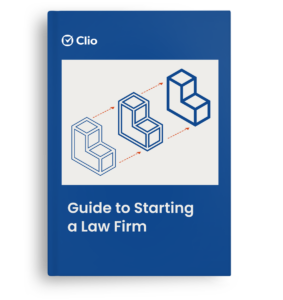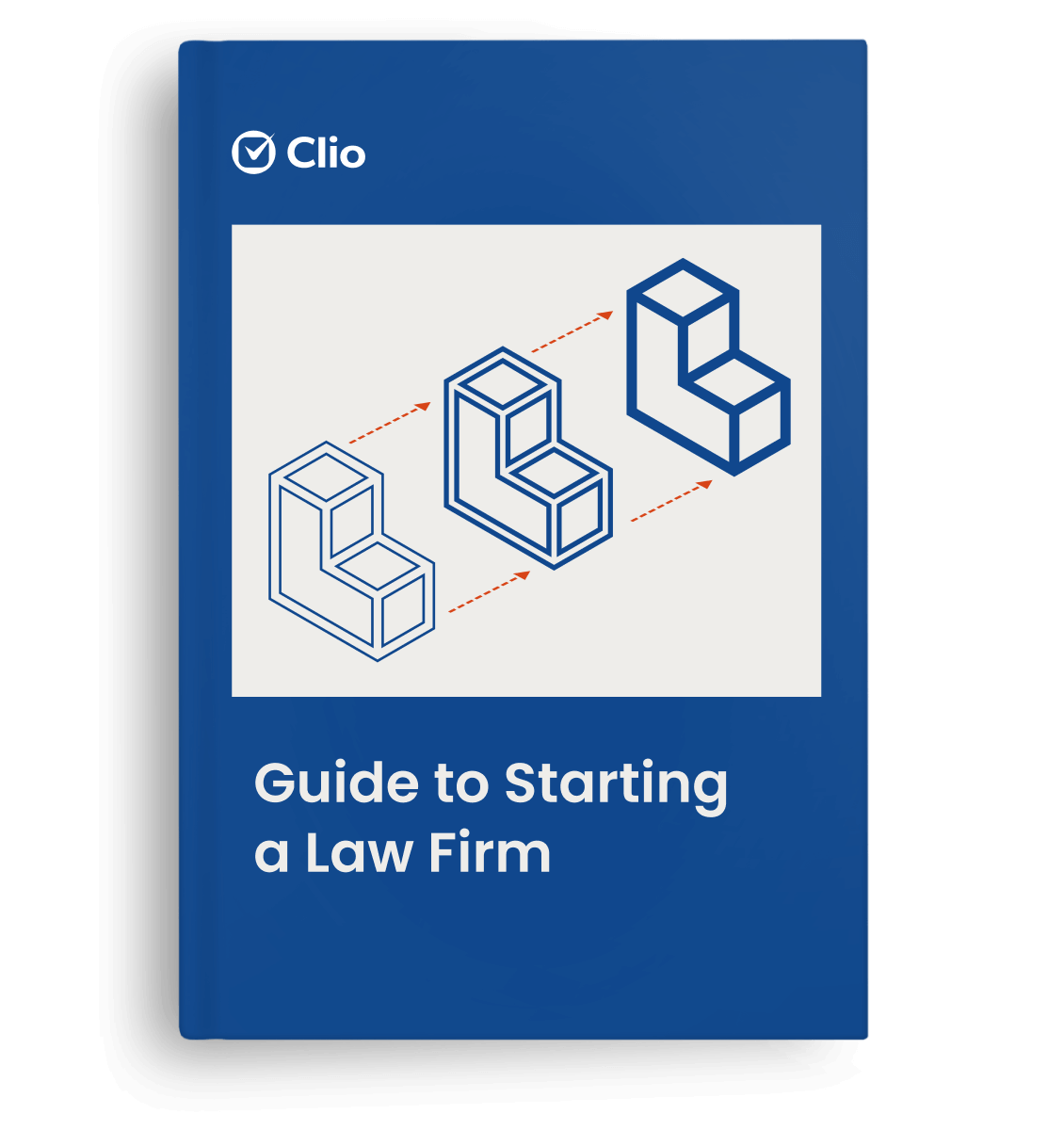Creating a marketing budget for a small law firm is integral for growth and success. And if you have zero experience building a marketing budget, you’re not alone. An American Bar Association survey found less than half (46%) of law firms and only 14% of solo attorneys reported having a marketing budget.
It’s a lot of work, and after all, you studied the law, not marketing. Follow the guide below to make this otherwise challenging task straightforward.
Discover the top highlights from our 2024 Legal Trends for Solo and Small Law Firms Report to gain insights on how small law firms are performing and industry wide trends.
How much do small law firms spend on marketing?
The U.S. Small Business Administration recommends spending 7%-8% of your firm’s gross revenue on marketing. Law firm management consultants encourage firms to spend 2% to 5%, but this number depends on the area of practice, geographical location, how established the law firm is, etc.
Learn more about the The U.S. Small Business Administration’s marketing budget recommendation for small law firms. You can also learn more about recommendations from law firm management consultants.

Retention vs. acquisition
At the most fundamental level, a marketing budget for a small law firm should include allocated resources for two areas of marketing: retention and acquisition. In other words—retaining existing clients and acquiring new ones.
Client retention
The budget and resources allocated to retention marketing depend on your area of practice. For example, an injury or divorce lawyer could run a retention campaign through a referral program. Ideally, your clients are so thrilled with your work that they go on to spread the word about your client-centered services.
You could also make it easy for clients to refer you to their friends by investing in email automation follow-ups or review requests. That way, you can help retain your clients as life-long brand champions.
Customer acquisition
Acquisition, on the other hand, is all about seeking out new clients. These folks have never heard of you before, and you need to be on the top of their mind when they need a lawyer. When it comes to creating a marketing budget for a small law firm, allocating resources to acquisition marketing will again be dependent on your area of practice and target audience.
While these two areas of marketing are crucial for every small firm or solo attorney to invest in, your area of practice will help you determine the resources to allocate to each area. If you’re a business lawyer working with entrepreneurs, your retention efforts will likely yield a higher return on investment (ROI). Thus, you should allocate more spending to retention. Whereas with criminal lawyers, you might find your ROI is higher when dollars are spent on acquiring new clients.
While your budgets should be strategic and measurable, they aren’t set in stone. As you track success, it’s more than okay to modify your budgets based on what works and what doesn’t.
Listen to Matters Episode 3: Why Client Acquisition Matters, a Clio podcast episode exploring why you need to optimize client acquisition at your law firm, and how you can do so.
How much do law firms spend on SEO?
Your practice area and geographical location will determine how difficult it will be to rank for keywords pertaining to your firm. Smaller law firms in less competitive markets might see results from spending hundreds of dollars a month on search engine optimization (SEO) activities.
We discuss incorporating SEO efforts into your marketing budget for small law firms below, under the awareness stage in the sales funnel.
How much to spend on digital marketing

It’s crucial to outline and understand your sales funnel before you determine a dollar figure for digital marketing initiatives.
Don’t let the sales terminology throw you off. The sales funnel is simply the path potential clients take to purchase. For lawyers and firms, it’s the journey a prospective client (lead) takes before signing on to work with you. At its core, a sales funnel has four stages:
- Awareness
- Interest
- Decision
- Action
We’ve explained the unique opportunities and challenges of each funnel stage below. We’ve also outlined campaign examples you can run to help leads on their journey. Understanding the four stages will help you confidently determine a feasible budget for efforts in each area.
Awareness
Your leads won’t know you exist without brand awareness. Your job is to ensure leads are aware of the services you offer. It might sound simple, but don’t be fooled. At the minimum, this stage requires you to show up wherever they go to find a lawyer. Seeing as how nearly 40% of clients find a lawyer via an online search engine, you should be investing in SEO for your website. Optimizing your overall search rankings will provide numerous ways for leads to discover your firm, click through to your website, and eventually book a consultation.
When allocating budget to this funnel stage, consider the current levels of awareness you’re generating. Try putting yourself in your leads’ shoes. Google some queries related to looking for a lawyer—be sure to use an incognito tab. If your website or ads pop up, chances are you’re doing the right things, and your budget is adequate. Another clue to help with budget allocation is your website traffic—the number of visits to your website. If you’re not getting consistent traffic every month, you might need to invest more into paid search ads or other SEO initiatives.
SEO-literate lawyers are at a big advantage when it comes to generating and converting leads. Read our guide: SEO for Lawyers: The Basics (with tips and examples).
Interest
Now that your lead is aware of your firm, it’s time to capture their interest. You might have a pop-up or landing page that serves as a hook for potential clients and piques their interest in your offerings. Using stories to relate to leads at this stage is one way you can build trust and ultimately form a relationship with leads. They should know a little bit about you and why you’re passionate about helping them through this stressful time in their life. If it’s difficult for you to write about yourself, consider hiring a freelance writer to communicate your work via a compelling story. Whether you write the copy yourself or not, the words and overall story need to serve as a hook to draw users in and ensure they feel empowered to move into the decision stage.
We encourage you to diversify your marketing activities and budget to increase the chances of connecting with as many leads as possible. Consider allocating a budget for business cards to help meet prospective clients and drive interest.
Decision
Encourage your leads to make the decision to seek more information or work with you. You’ll need to convince them how much they’ll benefit from your services. Displaying customer testimonials is one of the most effective ways to support someone in making a decision to work with you. Showcasing testimonials on your website, landing pages, and retargeting ads is one way to test at this funnel stage.
As mentioned above, when allocating budget to the various stages, it’s essential to know as much about the client journey as possible. Many factors will determine conversions at every step. For example, if you’re the only divorce lawyer in the city’s northside, you might not have very much keyword competition. Therefore, the awareness stage won’t require substantial spending. If you find your website has high bounce rates, you may want to invest more in the interest stage. High bounce rates indicate that you need to make website improvements to hold your leads’ attention.
See how Clio uses Customer Success Stories containing customer testimonials to increase trust online and encourage potential clients to use Clio.
Action
An action a potential client might take on your website could mean submitting their contact information, scheduling a consultation, subscribing to your email newsletter, or using a chatbot to have their initial questions answered. You can measure click-through rates (CTRs) and determine which actions are converting into leads. In this case, a conversion means a potential customer has successfully completed an action on your website, becoming a lead.
At every funnel stage, factors such as your area of practice and market competitiveness will contribute to how eager your website visitors will convert to leads. If they have many lawyers to choose from with intuitive websites, you’ll have to work harder to convert them.
Allocating spend in your marketing budget for small law firms for investing in lead generation services for lawyers is one way to optimize this funnel stage.
The American Bar Association does allow lawyers to pay for leads. However, Rule 7.2: Communications Concerning a Lawyer’s Services outlines some stipulations. The lead generator:
- Cannot recommend the lawyer
- Accepts payment consistent with ABA Rules 1.5 (e) and 5.4
- Communications are consistent with ABA Rule 7.1
While the ABA rules are clear on paying for leads, it’s always a good idea to verify the rules with your state bar association.
If you’re having trouble getting your leads to take action on your website, it might be worth hiring a law firm marketing consultant to help.
If you’ve considered starting your own law firm, we’re here to help you take the next step. Set yourself up for success with our free Guide to Starting a Law Firm.
You may like these posts
Define the cost of lead generation

It will be easier to create an effective marketing budget that works and keeps you on track by assigning a dollar value to a lead. It will also become clear which campaigns are delivering positive ROIs. After all, using leads as a measurement tool is an accurate way to measure the impact of your marketing initiatives.
The simplest way to determine the cost of a lead is to take all of your marketing efforts and divide it by the number of leads generated. It’s natural for this number to be its highest at the beginning of your marketing efforts. The more you invest in marketing and advertising, the more brand awareness you’ll build and the easier (and cheaper) it will be to convert leads.
Leverage cost-effective marketing strategies
Social media marketing
The capabilities of social media marketing allow you to run advertising tests in cost-effective ways. Take LinkedIn advertising, for example. The minimum daily budget to run ads on LinkedIn is just $10. You no longer need to invest thousands of dollars in billboards or print ads to test marketing designs and slogans.
It’s tough to compete with social media marketing when it comes to the cheapest way to reach your target market. This includes organic and paid social media. Having a Facebook page for your law firm—that’s updated consistently—is just as important as investing in paid Facebook advertising.
Outsource work
As difficult as it might be to delegate and trust others with important work at your firm, you can’t do everything. And as your business grows, you’ll need to get more comfortable with hiring professionals to take on work that’s outside of your domain.
This is a good thing, though—it allows you to focus on what you’re most passionate about. Let’s say you have a real knack for marketing and have seen positive results that continue to grow. You could bring in a consultant or agency. But you have a ton of research work to do that you don’t enjoy. Perhaps you might consider hiring a paralegal to support you with some of the legal research responsibilities so you can continue growing your brand awareness. That’s just one example—outsourcing will look slightly different for every firm.
Allocate budget for tools
When creating a marketing budget for small law firms, it’s essential to factor in the resources required to investigate, buy, and test new tools. For example, you may need a scheduling tool for social media posts or legal CRM software (to help you run automated email campaigns). Investigate the costs and benefits of these tools, and be sure to factor in the price tags when building your budget.
Don’t be afraid to ask for help
No one expects lawyers to be experts in marketing, finance, accounting, and business. Just as experts in other areas rely on lawyers for legal support, you should feel comfortable doing the same. Consider networking if you don’t have the funds to bring on a financial or marketing expert to give you feedback on your budget. Not only is networking with other lawyers a great way to build relationships and referrals but the same can be said for connecting with like-minded individuals outside of the legal world. Finding your community can lead to lifelong business relationships that will continue to support you throughout your legal (and entrepreneurial) life.
Budget your time
Time is money, and therefore time should be included in the marketing budget. While the numbers will vary, one legal consultant explains that you should devote at least four hours to marketing activities every week if you want to grow your business by 15-20% in 12 to 18 months.
Now that you’re acquainted with everything that should go into your marketing budget for small law firms, it’s time to put pen to paper. Utilize a free marketing budget template to help keep you on track and organized.
Conclusion
Crunching numbers and allocating spending might not be a fun way to spend an afternoon. But remember, these activities will help you connect with folks who need your legal expertise. The more time and strategy you put into your marketing activities, the more leads you’ll attract, the more people you’ll be able to help, and ultimately—the more your law firm will grow.
We published this blog post in January 2022. Last updated: .
Categorized in: Marketing







